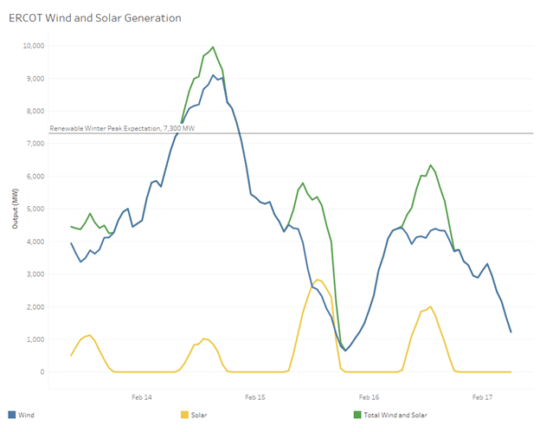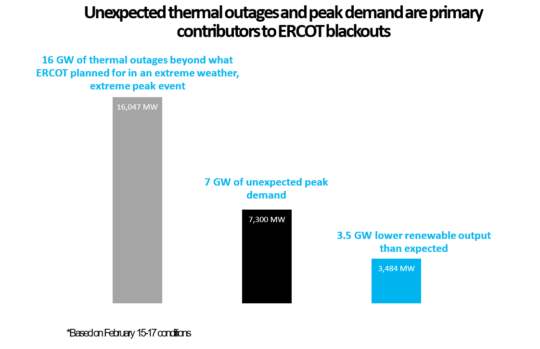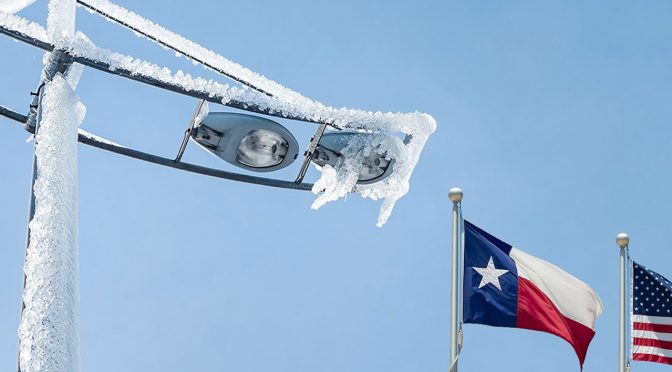Texas has suffered this week, but crisis reveals character. Record cold weather brought this state to the brink, but never brought Texas to its knees. Neighbors have come together to help neighbors, and everyone from front line responders to the engineers and experts who manage electricity production have worked around the clock to restore power.
That’s the real Texas.
But even amid an all-hands-on deck crisis, some seized the political opportunity to deceive and distort. The critics of clean power – those who attack it in rain, snow, or sun – started spinning a dangerous fiction to promote an agenda that has nothing to do with restoring power to Texas communities.
The facts of how Texas got here are not in dispute. Amid unprecedented, extreme storms, the state’s electricity generation failed. Thermal power plants failures – mainly coal and natural gas — are responsible for the overwhelming amount of power generation shortfalls. Texas has an extreme weather problem, not a clean power problem.
What happened
- More than 3.4 million Texas homes and businesses lost power during the event. The rare descent of a polar vortex so far south hit an electricity grid unaccustomed to such record-breaking low temperatures.
- The Texas grid operator, the Electric Reliability Council of Texas (ERCOT), said this period will go down in Texas weather history as one of the most extreme events to ever impact the state and that it was impacting all forms of electricity generation.
- The cold weather impacted thermal generation— natural gas, coal, and nuclear plants—the most.
- Skyrocketing natural gas prices coupled with difficulties in securing gas supply, frozen pipes, and even frozen wells caused major outages across the thermal fleet.
- At one point, ERCOT noted that as much as 34,000 megawatts (MW) of capacity was unavailable, mostly thermal plants. As of Tuesday morning, over 30,000 MW of thermal capacity were still unavailable.
But Clean energy opponents didn’t let the truth stand in the way of a good smear
In a crisis, some lean in and some lash out. Texans – first responders, engineers, utility workers – are leaning in to help their communities.
But too many are lashing out to make political hay out of tragedy. Those who have long opposed a newer, diversified energy mix despite a southwestern success story of new jobs and lower energy bills, are lashing out.
We’ll never have the energy debate we deserve if we’re stuck debating whether two plus two equals five.
- Fox News host Tucker Carlson told millions of Americans that the Lone Star State was “totally reliant on windmills.”
- President Trump’s former Energy Secretary suggested that if the Biden energy infrastructure approach succeeded “we’ll have more events like we’ve had in Texas all across the country.”
That’s simply incorrect.
Fact-checking the outright falsehoods:
- All resources on the Texas grid struggled with the extreme cold, but the failures at thermal plants have been described as “massive.”
- The large and unexpected decline in thermal plant capacity available at a time when overall demand peaked was significantly higher than ERCOT had estimated, even under its extreme contingency scenario.
- In its Seasonal Assessment of Resource Adequacy (SARA) for winter 2020-2021, ERCOT planned for a winter peak of 57,699 MW, yet ERCOT set a new winter peak demand record on Monday evening, February 15, reaching 69,150 MW. This is more than 3,200 MW higher than the previous winter peak set back in January 2018.
- ERCOT’s SARA projection expected nearly 83,000 MW of resource capacity available during winter peak demand, including 67,529 MW of thermal and hydro generation. However, actual capacity available was substantially lower. Throughout the crisis, ERCOT has been reporting an average of 30,000 MW of thermal capacity have been offline.
- Wind power actually performed close to grid operator’s expectation throughout this episode. “Wind is putting out more than we count on for the winter season,” said Dan Woodfin, senior director of system operations at ERCOT. Wind output has been consistently above ERCOT’s day-ahead and short-term (day-of) forecasts.

ERCOT’s SARA projection planned for between 1,800 MW and 7,000 MW of renewable energy to be online during peak winter events. Actual capacity in this recent event averaged around 4,000 MW and only briefly dipped below 2,000, as the chart above shows.
Thermal capacity – which is naturally expected to be less variable than wind – experienced the most unexpected outages. In an extreme peak, extreme outage event, ERCOT’s contingency plan assumed around 14,000 GW of thermal capacity would be unavailable. With more than 30,000 MW unavailable throughout most of this weather event, outages are more than double expectations. Such a large, sudden loss of power capacity coupled with a surge in demand forced the grid operator to ration electricity.

Grid challenges were widespread throughout the country, although the plight of homeowners and businesses in Texas was arguably the worst since this is a once-in-a-generation event and Texas infrastructure as a whole is not designed for such cold weather. While coal and gas failed in Texas, we’ve heard baseless accusations that wind energy doesn’t work in the winter. Never mind that Minnesota generates 21% of its electricity using wind and solar, North Dakota 29%, and South Dakota 30%. Wind turbines may shut down in extreme cold to prevent damage, but cold weather kits keep them operating when temperatures plunge. This is the norm in colder states and in Europe. It’s never been necessary in the Texas climate; winterizing wind turbines in Texas would be like buying a down coat for the winter in Miami.
The big picture
Clean power like wind and solar are a key part of mitigating climate change, and climate change is the primary culprit behind weather disruptions that can lead to rare instances of a punishing polar vortex dropping so far south in the U.S. Make no mistake, extreme weather – and we’ll see more of it because of climate change – is a challenge to every form of energy production. Coal yards in Texas flooded during Hurricane Harvey, forcing coal plants offline; nuclear plants along the Florida coastline had to shut down due to concerns over storm surges; coal piles froze and natural gas pipelines failed during the 2014 Polar Vortex due to the extreme cold, while renewable energy generators kept generating.
Is clean power reliable? No question. At times, wind energy provides 60% or more of the total electricity in the Southwest Power Pool, a system that encompasses parts of 14 states and stretches from Texas to North Dakota. Six states generate more than 20% of their electricity from wind.
There’s an old Texas saying, “storms make trees take deeper roots.” Storms topple trees that don’t have deep roots, and test those that do. In energy, our infrastructure is our roots. They’re there when you need them. There are storms that can’t be predicted, and then there are those that should be foreseen. States should invest in the deepest of roots while we have the chance – and the time – to weather this year’s storms and tame the next one.
Author:
Heather ZichalChief Executive Officer


